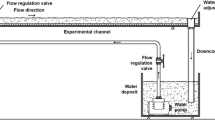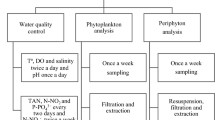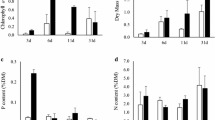Abstract
In a mesocosm experiment, pigment levels, organic matter and the structure of macroinvertebrate community were compared in two linked wetland systems encompassing fish-farm pond and natural reservoir. A stratified sampling design was applied, and treated experimental azoic sediment was placed in suspended boxes. The set of box was used to follow cumulative colonization period and single-month colonization approach for the study of macrofauna and biochemical parameters (organic matter, chlorophyll a and phaeopigments). There were significant differences between systems for the abiotic and community variables and polychaete diversity. Regarding the structure of macroinvertebrate community, the pond system appears to have higher abundance than the natural system. Monthly fluctuation was observed for abiotic variable and community variables in both systems, but polychaete diversity indices did not vary monthly in the pond system, which suggests that diversity indices in disturbed systems do not follow the organic matter variation. The correlation coefficient was also tested within abiotic and community variables for both systems. In the pond system, the organic matter was strongly related with chlorophyll a, carotenoid and phaeopigments. Due to the fact that the source of OM in the pond system is allochthonous, phaeopigments level is likely not to be directly affected by organic matter enrichment, but organic matter inputs create the high primary production and consequently affect the phaeopigments level. Polychaete abundance was positively correlated with the load in organic matter for both reservoir and pond systems, but the correlation coefficient between organic matter and polychaete diversity indices was higher in reservoir than in the pond system. The Moss index was used to indicate the production and degradation state of the systems, and it represented the natural reservoir in a higher production phase than the fish pond, and later on, the monthly variation of the percentage of degradation confirms the pond system in a more decayed state than the natural reservoir system. This study shows that although the organic matter and phaeopigments level tend to be higher in disturbed system, this does not necessarily favor all species, and more sensitive species are endangered of getting displaced by opportunistic species in systems with anthropogenic impact.



Similar content being viewed by others
References
Abele-Oeschgerl D, Szaniawska A, Theede H (1992) Do pigments reflect the turnover of plant material in food chain studies? Analysis of plant pigments in the intestine of Saduria mesidotea entomon. Mar Ecol Prog Ser 81:43–49
Adams MS, Prentki RT (1986) Sedimentary pigments as an index of the trophic status of Lake Mead. Hydrobiologia 143:71–77
Andrade P, Erzini K, Palma J (1996) Gastric evacuation and feeding in the gilthead sea bream reared under semi intensive conditions. Aquac Int J 4:129–141
Arntz WE, Rumohr H (1982) An experimental study of macrobenthic colonization and succession, and the importance of seasonal variation in temperate latitudes. J Exp Mar Biol 64:17–45
Byers SC, Mills EL, Stewart L (1978) A comparison of methods of determining organic carbon in marine sediments, with suggestions for a standard method. Hydrobiologia 58:43–47
Cancela da Fonseca L, Costa AM, Bernardo JM, Fonseca R (1987) Lagoa de Santo André SW Portugal: phytopigments as sedimentary tracers. Limnetica 3:299–306
Carvalho S, Barata M, Pereira F, Gaspar MB, Cancela da Fonseca L, Pousão-Ferreira P (2006) Distribution patterns of macrobenthic species in relation to organic enrichment within aquaculture earthen ponds. Mar Pollut Bull 52:1573–1584
Clarke KR, Warwick RM (1994) Change in marine communities, an approach to statistical analysis and interpretation. Primer-E Ltd, Plymouth Marine Laboratory, Plymouth
Dauvin JC (1984) Revue des principales techniques utilisées pour l’étude expérimentale de l’établissement de peuplements macrobenthiques subtidaux de sédiment meuble, premiers résultats des expérimentations réalisées en Baie de Morlaix. Oceanis 10:237–258
Eaton L (2000) Development and validation of biocriteria using benthic macroinvertebrates for North Carolina estuarine waters. Mar Pollut Bull 42:23–30
Ekpenyong E (2000) Algal biomass and pigment diversity in typical tropical fish ponds. Trop Ecol 41:89–94
Flint RW, Duke TW, Kalke RD (1982) Benthos investigations, sediment boxes or natural bottom. Bull Environ Contam Toxicol 28:257–265
Gauch HG Jr (1982) Multivariate analysis in community ecology. Cambridge University Press, Cambridge
Guérrin JP, Massé H (1978) Étude expérimentale sur le recrutement des espèces de la macrofaune bentique des substrats meubles. 1—méthodologie-donnés qualitatives et quantitatives. Tethys 8:151–168
Guilizzoni P, Bonomi G, Galanti G, Ruggiu D (1983) Relationship between sedimentary pigments and primary production: evidence from core analyses of twelve Italian lakes. Hydrobiologia 103:103–106
Holmer M (1991) Impacts of aquaculture on surrounding sediments, generation of organic-rich sediments. In: Pauw ND, Joyce J (eds) Aquaculture and the environment. European Aquaculture Society. Special Publication 16, pp 155–176, Belgium
Karakassis I, Hatziyanni E (2000) Benthic disturbance due to fish farming analyzed under different levels of taxonomic resolution. Mar Ecol Prog Ser 203:247–253
Krebs CJ (1989) Ecological methodology. Harper Collins, New York
Kristensen E, Anderson FØ (1987) Determination of organic carbon in marine sediments: a comparison of two CHN-analyser methods. J Exp Mar Biol Ecol 109:15–23
Kruskal JB (1964) Multidimensional scaling by optimizing goodness of fit to a non-metric hypothesis. Psychometrika 29:1–27
Liaaen-Jensen S (1991) Marine carotenoids: recent progress. Pure Appl Chem 63:1–12
Lorenzen CJ (1967) Determination of chlorophyll and phaeopigments: spectrometric equations. Limnol Oceanogr 12:343–346
MAFF (1993) Analysis and interpretation of benthic community data at sewage-sludge disposal sites. Aquatic Environment Monitoring Report No. 37, MAFF Directorate of Fisheries Research, Lowestoft, UK, 80 pp
Marcovecchio J, Freije H, De Marco S, Gavio A, Ferrer L, Andrade S, Beltrame O, Asteasuain R (2006) Seasonality of hydrographic variables in a coastal lagoon: Mar Chiquita, Argentina. Aquat Conserv Mar Freshw Ecosyst 16:335–347
McKinney RA, Raposa KB, Cournoyer RM (2011) Wetlands as habitat in urbanizing landscapes: patterns of bird abundance an daccupancy. Landsc Urban Plan 100:144–152
Morrisey DJ, Gibbs MM, Pickmere SE, Cole RG (2000) Predicting impacts and recovery of marine-farm sites in Stewart Island, New Zealand, from the Findlay—Watling model. Aquaculture 185:57–271
Moss B (1967) A spectrophotometric method for the estimation of percentage degradation of chlorophylls to pheopigments in extracts of algae. Limnol Oceanogr 12:335–340
Newton A, Icelya JD, Falcaocb M, Nobred A, Nunesd JP, Ferreira JG, Valec C (2003) Evaluation of eutrophication in the Ria Formosa coastal lagoon, Portugal. Cont Shelf Res 23(17–19):1945–1961
Norkko A, Rosenberg R, Thrush SF, Whitlatch RB (2005) Scale- and intensity-dependent disturbance determines the magnitude of opportunistic response. J Exp Mar Biol Ecol 330:195–207
Paulson LJ, Baker JR (1980) Nutrient interactions among reservoirs on the Colorado River. In: Stefan HG (ed) Symposium on surface water impoundments ASCE 2–5 June, Minneapolis, MN, pp 1647–1656
Pearson TH, Rosenberg R (1978) Macrobenthic succession in relation to organic enrichment and pollution of the marine environment. Oceanogr Mar Biol Annu Rev 16:229–311
Pielou EC (1966) Species-diversity and pattern diversity in the study of ecological succession. J Theor Biol 10:370–383
Pielou EC (1977) Mathematical ecology. Wiley-Interscience, New York
Plante-Cuny MR (1974) Evaluation par spectrophotometrie des teneurs en chlorophylle a fonctionnelle et en pheopigments des substrats meubles marins. Documents Scientifiques de la Mission de l’ O.R.S.T.O.M. a Nosy-Be 45, p 76, France
Prentki RT, Paulson LJ (1983) Historical patterns of phytoplankton productivity in Lake Mead. In: Adams M, Lamarra V (eds) Aquatic resources management of the Colorado River Ecosystem, Chap. 8, pp 105–123
Santos F, Forbes K, Moita R (2002) Climate change in Portugal. Scenarios, impacts and adaptation measures—SIAM project. Gradiva, Lisboa
Seilheimer TS, Mahoneya TP, Chow-Frasera P (2009) Comparative study of ecological indices for assessing human-induced disturbance in coastal wetlands of the Laurentian Great Lakes. Ecol Indic 9(1):81–91
Shepard RN (1962) The analysis of proximities: multidimensional scaling with an unknown distance function. II. Psychometrika 27:219–246
Shishehchian F, Yusoff FM, Shariff M (2001) The effects of commercial bacterial products on macrobenthos community in shrimp culture ponds. Aquacult Int 9:429–436
Simenstad CA, Fresh KL (1995) Influence of intertidal aquaculture on benthic communities in Pacific Northwest estuaries: scales of disturbance. Estuaries Coast 18(1):43–70
Sprung M (1994) Macrobenthic secondary reduction in the intertidal zone of Ria Formosa-a lagoon in Southern Portugal. Estuar Coast Shelf Sci 38:539–558
Strickland JDH, Parsons TR (1972) A practical handbook of seawater analysis. Bull Fish Res Board Can 167:1–310
Tavares PC, Machado M, Cancela da Fonseca L (2008) Colonization process in soft-bottom macrofauna communities using azoic sediments: comparison of two wetland systems with different organic loads. Fundam Appl Limnol 171:219–232
Weston DP (1990) Quantitative examination of macrobenthic community changes along an organic enrichment gradient. Mar Ecol Prog Ser 61:233–244
Zajac RN, Whitlatch RB (1982) Responses of estuarine infauna to disturbance. I—spatial and temporal variation of initial recolonization. Mar Ecol Prog Ser 10:1–14
Zar JH (1996) Biostatistical analysis. Prentice-Hall, International Editions, New Jersey
Zuur AF (2003) Analysing biological and environmental field data. Highland Statistics Ltd, Aberdeenshire
Acknowledgments
This work was done by Paula Tavares (1972–2009), and she had submitted the paper previously, but unfortunately she did not have chance to finish the final version of the article like it is now. This study supported by JNICT/STRIDE—STRD/MAR/0150. Authors are indebted to the staff of Aquamarim for helps during the field work and also to Prof. Leonor Cancela and Ana Silva for the main revision of the manuscript.
Author information
Authors and Affiliations
Corresponding author
Rights and permissions
About this article
Cite this article
Shapouri, M., Tavares, P.C., Martins, C. et al. Using pigment level as a primary production indicator to assess organic matter variability in two linked wetland systems with different disturbance levels and its effect on secondary communities. Aquacult Int 21, 111–128 (2013). https://doi.org/10.1007/s10499-012-9539-z
Received:
Accepted:
Published:
Issue Date:
DOI: https://doi.org/10.1007/s10499-012-9539-z




